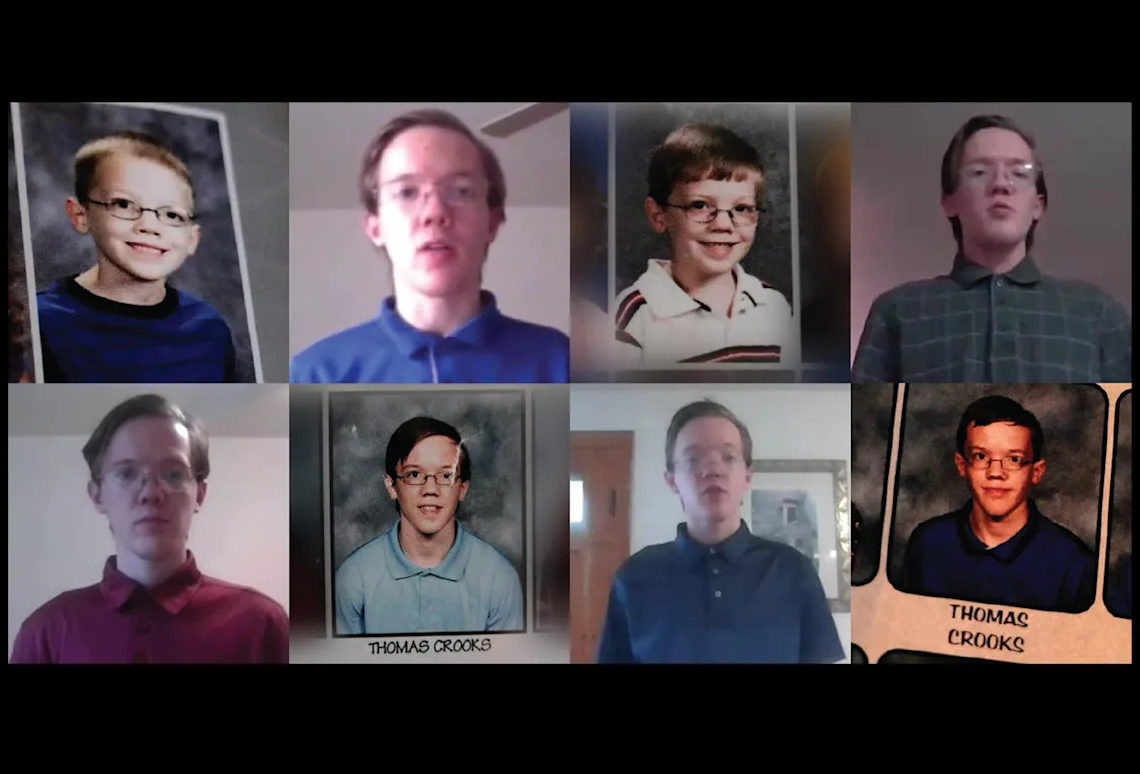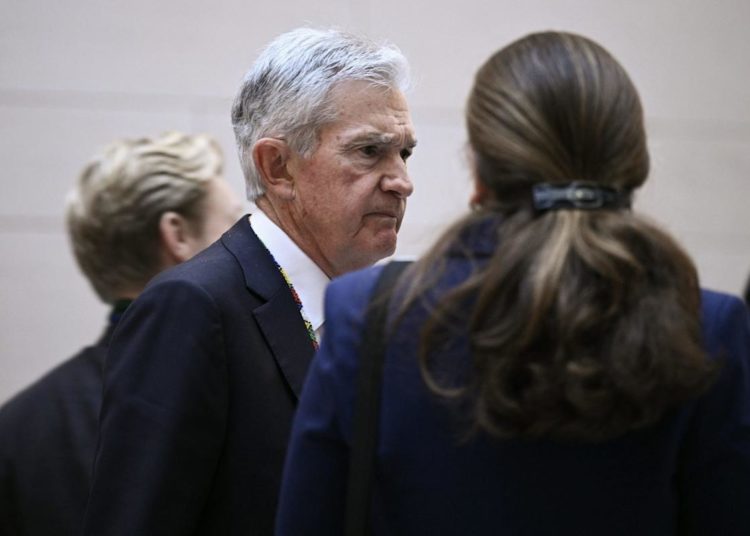Before Thanksgiving 2023, Thomas Crooks’ online life was fairly routine for a 20-year-old. He’d scroll through social media, listen to music on Spotify, visit news sites and peruse Reddit.
But a plan for mass violence was brewing, and in order for it to succeed, Crooks had to compartmentalize his life. It was something he was already comfortable doing from a childhood in which he let few people get close.
Friends knew little about his home and tight-knit family. They were rarely invited over to the Crooks home to play or, as they got older, hang out. In late 2023, he pivoted to keeping a new set of secrets — building homemade improvised explosive devices in his bedroom and planning an assassination, while pursuing a career in engineering.
On July 13, 2024, Crooks would take aim at a rally for President Trump in the small town of Butler, Pennsylvania, firing from a rooftop eight shots that came within inches of dramatically altering the course of American history. He left no manifesto, no explanation for why he tried to kill the former and future president. In the year since the shooting, investigators and those who knew him have been trying to piece together what led him to climb that roof in Butler, with frustratingly few answers.
This CBS News investigation provides the most comprehensive portrait yet published of the insular young student. It draws from interviews with more than two dozen friends, professors, law enforcement officials and others, as well as open records requests to half a dozen agencies and a review of thousands of documents.
The young man who died in the assassination attempt crafted a furtive double life in the months leading up to the attack, unbeknownst to the people closest to him.
The “nice” boy who “kept to himself”
Crooks was born in 2003 and lived his entire life in a suburban home purchased by his parents before he and his older sister came along, tucked along a leafy street in Bethel Park, Pennsylvania, just outside Pittsburgh. Growing up, Crooks loved Legos, his cat, building and creating model airplanes, watching the Pittsburgh Steelers and cooking with family.
His parents were both social workers, and took pride in their work and family. In 2008, his father, Matthew, filled out an online registry for a family coat of arms, writing that he hoped to pass down to his young children a sense of family unity and instill in them the virtues of generosity, sincerity, hope, joy and service to the country.
Crooks and his mother, who is visually impaired, often prepared dinner together. During holidays, everyone helped out. “For Thanksgiving, me and my dad will cook turkey and mashed potatoes together. At Christmas, me and my mom will bake dozens of cookies together, and on New Year’s Eve, my mom and I will bake the pork and the sauerkraut together,” Crooks said in a video he recorded for a college class.
In kindergarten, Crooks met Tristan Radcliffe. They ate lunch together frequently throughout most of elementary, middle and high school, and kept in touch after they both enrolled at the same college.
“I’ve known Tom, like, all of my life,” Radcliffe said. “He was cool. You know, he was kind of just Tom to me.”
There were many things about Crooks that stayed familiar and consistent through the years: his tight jeans, his tidy shirts and his bespectacled smooth face beneath neatly parted hair. But there was plenty, Radcliffe said, that he never knew about his friend, even though they saw each other nearly every day.
He was never invited to Crooks’ home, and Crooks rarely talked about his family. Radcliffe said Crooks was a “nice” boy who “kept to himself.” Crooks’ neighbors said the family didn’t interact much with folks on their block, and the children rarely had visitors.
Radcliffe wasn’t bothered by it. To him, Crooks seemed like he had more on his mind.
“He always seemed like he focused on his work more, you know, like he came off smart,” Radcliffe said.
Crooks’ grades and test scores supported that. Crooks scored 1530 on his SAT exam, putting him in the 99th percentile nationally. He enrolled in the Community College of Allegheny County in 2022, and told an adviser he was saving money before pursuing a four-year engineering program.
As the tight quarters and crowded classrooms of high school gave way to the sprawl and remote coursework of commuter college, Crooks’ social connections largely evaporated, allowing his secret life to go largely unnoticed.
A star student walking two paths
A diligent college student, Crooks routinely contacted professors to make sure his grades remained high.
His teachers were impressed with his work, often lauding his effort and dedication. One emailed to compliment Crooks for “getting such an early start” on a project. Another wrote to thank him for his contributions to class all semester.
Crooks stood out among his peers, according to former engineering professor Patricia Thompson.
“I thought he was a star student. He had his head on straight and he was on a path [to] success,” Thompson said.
She recalled showing other professors in her department one of Crooks’ projects which exceeded her expectations. He designed and 3D-printed a unique chessboard, engineered for players with visual impairments.
For many others contacted by CBS News, Crooks did not leave a lasting impression. Several former students said they did not realize he had been in the same class. Even some who had emailed and worked on projects with Crooks said they couldn’t recall interacting with him.
For one assignment, Crooks was called upon to record a speech in front of an audience of five adults. He emailed his professor seeking to be excused from that requirement.
“I currently only live with my Mom and Dad. There are no other adults in my house and I have one sister who lives nearby that could potentially come over to be part of this audience,” Crooks wrote. “I do not have access to any other adults.”
In the summer of 2023, Crooks bought a rifle from his dad for $500 and signed up for a membership at a local shooting range. He became a regular at Clairton Sportsmen’s Club, about nine miles from his home, signing in to use the rifle range more than 40 times in the last 11 months of his life, records show. Around that time, records obtained by CBS News show he started using encryption services that masked some of his internet use, mixing those with more typical visits to sites like Facebook, Instagram, TikTok and X.
His habits started to rapidly shift that fall. To his professors, he still appeared focused on getting straight A’s and preparing to apply to the engineering programs at the University of Pittsburgh and Robert Morris University. But his online activity suggests his attention was elsewhere. He began to more frequently use an encrypted email service called Mailfence and a virtual private network called Mullvad. Both would shield his online life from anyone who might pry.
An analysis by CBS News of Crooks’ internet routines shows he developed an increasing interest in news, explosives and ammo, and secrecy. The records include nearly a year of Crooks’ activity on his college’s wireless internet network. They show hundreds of visits to websites ranging from his academic email account and discussion boards, to his bank, news sites, gaming platforms, social media, weapons blogs and Steelers fan sites.
Logs of Crooks’ on-campus internet activity, which CBS News obtained through a public records request, indicate that in the last months of his life, he became increasingly rigid about secrecy, shrouding his activities through encrypted services.
Two particular days — Dec. 6, 2023, and Jan. 24, 2024 — stand out. On Dec. 6, 2023, Crooks checked various news sites and the White House website’s archives from Mr. Trump’s first administration, followed by visits to firearms websites. The following month, on Jan. 24, Crooks showed the single largest number of internet requests in the logs, at 1,364. He started to consistently use the VPN after that day.
On some days, he left little trace of his activity, choosing instead to first turn on Mullvad. Virtual private networks, known as VPNs, route a user’s web traffic through encrypted tunnels, hiding their activity from prying eyes, such as a college’s web tracking security software. While Crooks was using Mullvad, his browsing history was effectively sealed off.
Mullvad CEO Jan Jonsson told CBS News that the VPN service used by Crooks was designed to “provide anonymity, censorship circumvention and surveillance protection.”
“This sadly also means that if somebody abuses the service for nefarious purposes, we cannot block that individual user and unfortunately can’t provide any additional information about them,” Jonsson said.
In December 2023, a month before Crooks’ final semester started, his life began to split in two. He was focused on his college applications, and at the same time fixated on mass violence. One day, he emailed himself to review his personal statement for his application; on another, he emailed customer service to complain that the explosive fuel he ordered had not yet shipped. Investigators later concluded he would have been able to engineer bombs in his bedroom without his parents knowing.
Around this time, some in Crooks’ life did notice erratic behavior.
Crooks’ father told investigators that, in retrospect, he spotted signs of his son’s declining mental health, according to excerpts of a Pennsylvania State Police report. Those excerpts were first made public in December by a House of Representatives task force on the attempted assassination.
“Crooks’ father explained that within the last year he observed several instances of his son dancing in his bedroom throughout the night,” a Pennsylvania investigator wrote. “He would occasionally see Crooks talking to himself with his hands moving, which he expressed as uncommon and had become more prevalent after he had finished his last semester.”
Radcliffe noticed similar changes when he bumped into Crooks on campus.
“He would always move his legs around a lot, and he would kind of talk pretty fast,” Radcliffe recalled.
Crooks graduated from community college in May 2024. On June 14, less than a month before the assassination attempt, he sent one last email from his community college account.
It was to the registrar. Crooks wanted to know when he’d receive his diploma.
Searching for the opening he needed
In the month before July 13, Crooks turned his attention to the presidential campaign, researching the candidates online more than 60 times, including searches on July 5 for “DNC convention” and “when is the RNC in 2024,” according to the FBI. He visited the Butler Farm Show grounds in person on July 7, and searched for “butler farm show photos,” according to investigators. He also researched AGR International, a company with buildings adjacent to the grounds.
The day before the attack, July 12, Crooks made one last visit to the rifle range.
On the morning of the attack, Crooks drove to the Butler Farm Show grounds, and stayed for a little more than an hour before driving home.
Investigators said that at about 1:30 p.m., Crooks got his rifle from the house. It was the gun he had purchased from his dad the year before. Crooks’ father told investigators he believed his son was going to the range.
In addition to the rifle, Crooks put a drone and two homemade bombs in his trunk, along with remote transmitters capable of detonating them from more than 1,000 feet away. He left a partially assembled explosive device in his bedroom.
Crooks went to a store near his home and bought ammunition, according to investigators, and then returned to the Butler Farm Show grounds. As Trump supporters lined up to enter the highly publicized rally in the height of the presidential campaign, Crooks took a drone out of his car and flew it over the rally site for nearly 12 minutes, beginning at 3:51 p.m., potentially using the drone’s cameras to view the podium where Mr. Trump would soon speak.
Three local police officers first noticed Crooks around 5 p.m. One officer, a sniper, said Crooks “stood out.” Crooks was alone, the officers noted, and he wasn’t paying attention to the campaign festivities.
“He was walking around the grassy area between AGR and the secondary fence line, kept looking up, looking at the building. One point that is what raised my suspicion is he was looking directly at the window I was positioned at,” the sniper told investigators. The AGR building was approximately 150 yards from where Mr. Trump was speaking.
Local officers began keeping tabs on Crooks. One saw him using a rangefinder and snapped photos of him. At 5:39 p.m., one officer suggested notifying the Secret Service about the suspicious young man.
A Pennsylvania State Police sergeant later told investigators that he alerted Secret Service personnel to the suspicious person. Congressional task force investigators said there’s no indication that message reached Secret Service personnel on the stage or in charge of security.
Just after 6 p.m., an officer saw Crooks near a picnic table, and watched him grab a backpack before he “took off running,” one local officer told investigators. Officers began to leave their posts to look for Crooks, who had seemingly disappeared between two buildings.
Butler County District Attorney Richard Goldinger said in an interview with CBS News that poor planning and communication gave Crooks the opportunity he had been seeking.
“Local police weren’t apprised of the Secret Service’s security plan until the afternoon of the shooting,” Goldinger said. “It was never specified to local law enforcement that they were assigned to secure the area where Crooks was able to climb onto the building.”
Secret Service deputy director Matt Quinn said the agency tasked with protecting Mr. Trump bears responsibility for what happened next.
“I would ask Americans to understand that it was an organizational failure within the Secret Service, and we are laser focused on making sure that it never happens again,” Quinn said.
At 6:02 p.m., Mr. Trump took the stage. Crooks ascended to the rooftop three minutes later. Panicked bystanders began calling the police.
At 6:11 p.m., moments before Crooks opened fire, a Butler detective decided to pursue Crooks on the roof. He later described to congressional investigators the look on Crooks’ face as the detective began to pull himself up.
“I see Crooks facing downrange towards the stage, but his eyes are back at me as I’m coming up. And I would say, like, his facial expression was surprised. His eyes were very big, like, what are you doing up here?” the local detective said.
Crooks turned his gun toward the detective, who fell backwards and immediately radioed that the suspect was armed. The message never made it to the security detail for Mr. Trump.
A few seconds later, Crooks fired eight shots, killing firefighter Corey Comperatore, injuring Mr. Trump and two others. A Secret Service sniper returned fire, hitting Crooks in the face and killing him.
“The shooter is down. He’s down hard,” a local police officer radioed. Mr. Trump was swarmed by Secret Service agents trying to remove him from the stage.
“Wait,” Mr. Trump said, before he stood, raised his fist and yelled to the crowd, “Fight! Fight! Fight!”
Unanswered questions remain
Law enforcement soon descended on Bethel Park, tracing Crooks via the gun he purchased from his father. By 10:45 p.m., covert surveillance of the Crooks home was in place, but just 11 minutes later, his father called 911. He said he was worried because his son had not returned after saying much earlier in the day he was going to the local gun club. When agents knocked on his door, Matthew Crooks asked, “Is it true?” He said someone from CNN had called and said his son “shot Trump.”
Investigators questioned him and Crooks’ mother. They fanned out across Bethel Park, Butler and Pittsburgh, interviewing Radcliffe and Thompson — seemingly anyone who had ever interacted with Crooks. They checked with the local library, and learned Crooks didn’t have a library card. A grand jury subpoenaed his online activity and coursework from college, the same material later reviewed by CBS News.
Investigators visited the gun club, the store where Crooks bought ammo and one where he purchased a ladder that day. They scoured videos from before, during and after the campaign rally, as well as local and federal law enforcement communications.
Details emerged about Crooks’ planning. But nearly a year later, many unanswered questions about his motivation remain. Crooks left no known written explanation. His political leanings remain unclear. Was the Butler rally just a convenient option for a young man planning mass violence, or was he committed to shooting Mr. Trump? Did he have a plan for his bombs? Did he understand he was on a suicide mission?
Already isolated before the shooting, Crooks’ parents are now rarely seen outside during daylight hours. A neighbor said there are only a few clues to suggest the family even still resides at the home. Another neighbor described the Crooks family’s presence on their street as “ghostlike.”
Crooks’ parents did not respond to interview requests. Their attorney declined to speak on their behalf.
A postal employee said the mailbox is always empty when he delivers each day’s mail. He and the neighbors speculated that the couple leave their home under the cover of darkness. Their house, which now has multiple security cameras, is blurred on Google Maps, an option homeowners concerned about privacy can request from the search giant.
Mary Crooks submitted her resignation from the job she’s held for nearly three decades in December. The resignation letter, first reported by The New York Times, alludes to the shooting as the reason for her departure.
“Certain circumstances have left me with no other option than to vacate a position I have been proud to hold for the past 27 years,” she wrote. She and her husband let their social work licenses expire in February.
Others in Crooks’ life are still haunted by their connection to him.
Thompson compiled Crooks’ discussion responses and projects from her class into one document. She studied it, looking for answers.
“Why would this kid who had his whole future, you know, laid out for him, [a] positive future — why would he do something like this?” she asked.
Radcliffe recalls seeing Crooks’ image from Butler blanketed across the airwaves the day of the shooting. The kempt scrawny kid replaced by a man whose wispy hair ran to his shoulders, a faint goatee over a t-shirt for a gun enthusiast’s YouTube channel.
“I’m still in disbelief about the whole thing to be honest. Because it really just doesn’t make sense. It just doesn’t make any sense whatsoever,” Radcliffe said.
Social media content creator shows his hustle
Udemy Is Powering Enterprise AI Transformation Through Skills
One year after Thomas Crooks tried to kill President Trump, here’s what’s known about him
The post The secret double life of Thomas Crooks, Trump’s would-be assassin appeared first on CBS News.



